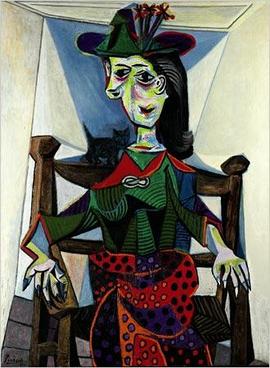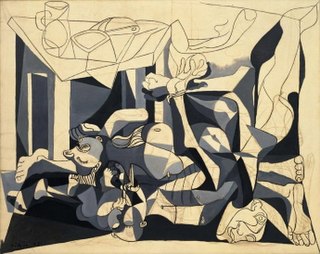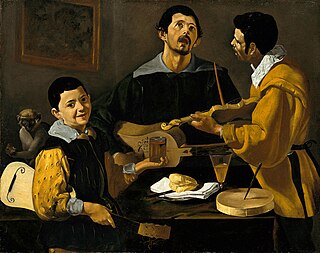Three Musicians may refer to:
- Trio (music)
- Three Musicians (Picasso), either of two oil paintings of the same subject by Pablo Picasso
- Three Musicians (Velázquez), an oil painting by Diego Velázquez
Three Musicians may refer to:

Georges Braque was a major 20th-century French painter, collagist, draughtsman, printmaker and sculptor. His most notable contributions were in his alliance with Fauvism from 1905, and the role he played in the development of Cubism. Braque's work between 1908 and 1912 is closely associated with that of his colleague Pablo Picasso. Their respective Cubist works were indistinguishable for many years, yet the quiet nature of Braque was partially eclipsed by the fame and notoriety of Picasso.

Pablo Ruiz Picasso was a Spanish painter, sculptor, printmaker, ceramicist, and theatre designer who spent most of his adult life in France. One of the most influential artists of the 20th century, he is known for co-founding the Cubist movement, the invention of constructed sculpture, the co-invention of collage, and for the wide variety of styles that he helped develop and explore. Among his most famous works are the proto-Cubist Les Demoiselles d'Avignon (1907) and the anti-war painting Guernica (1937), a dramatic portrayal of the bombing of Guernica by German and Italian air forces during the Spanish Civil War.

Diego Rodríguez de Silva y Velázquez, Knight of the Order of Santiago was a Spanish painter, the leading artist in the court of King Philip IV of Spain and Portugal, and of the Spanish Golden Age.

Las Meninas is a 1656 painting in the Museo del Prado in Madrid, by Diego Velázquez, the leading artist of the Spanish Baroque. It has become one of the most widely analyzed works in Western painting for the way its complex and enigmatic composition raises questions about reality and illusion, and for the uncertain relationship it creates between the viewer and the figures depicted.

The Museo Nacional Centro de Arte Reina Sofía is Spain's national museum of 20th-century art. The museum was officially inaugurated on September 10, 1992, and is named for Queen Sofía. It is located in Madrid, near the Atocha train and metro stations, at the southern end of the so-called Golden Triangle of Art.

Guernica is a large 1937 oil painting by Spanish artist Pablo Picasso. It is one of his best-known works, regarded by many art critics as the most moving and powerful anti-war painting in history. It is exhibited in the Museo Reina Sofía in Madrid.

Picasso's African Period, which lasted from 1906 to 1909, was the period when Pablo Picasso painted in a style which was strongly influenced by African sculpture, particularly traditional African masks and art of ancient Egypt, in addition to non-African influences including Iberian sculpture, and the art of Paul Cézanne and El Greco. This proto-Cubist period following Picasso's Blue Period and Rose Period has also been called the Negro Period, or Black Period. Picasso collected and drew inspiration from African art during this period, but also for many years after it.

The Old Guitarist is an oil painting by Pablo Picasso, which he created in late 1903 and early 1904. It depicts an elderly musician, a haggard man with threadbare clothing, who is hunched over his guitar while playing in the streets of Barcelona, Spain. It is on display at the Art Institute of Chicago as part of the Helen Birch Bartlett Memorial Collection.

The painter Francis Bacon was largely self-taught as an artist. As well as other visual artists, Bacon drew inspiration from the poems of T. S. Eliot, Ezra Pound and Yeats, the plays of Aeschylus, Sophocles and Shakespeare; Proust and Joyce's Ulysses.

Dora Maar au Chat is an oil-on-canvas painting by Pablo Picasso. It was painted in 1941 and depicts Dora Maar, the artist's lover, seated on a chair with a small cat perched on her shoulders. The painting is listed as one of the most expensive paintings, after achieving a price of $95 million at Sotheby's on 3 May 2006. It is currently the sixth-highest-selling painting by Picasso.
The Three Dancers is a painting by Spanish artist Pablo Picasso, painted in June 1925. It is an oil on canvas and measures 84.8 in x 56 in .

Three Musicians, also known as Musicians with Masks, is a large oil painting created by Spanish artist Pablo Picasso. He painted two versions of Three Musicians. Both versions were completed in the summer of 1921 in Fontainebleau near Paris, France, in the garage of a villa that Picasso was using as his studio. They exemplify the Synthetic Cubist style; the flat planes of color and "intricate puzzle-like composition" giving the appearance of cutout paper with which the style originated. These paintings each colorfully represent three figures wearing masks. The two figures in the center and left are wearing the costumes of Pierrot and Harlequin from the popular Italian theater Commedia dell'arte, and the figure on the right is dressed as a monk. In one version, there also is a dog underneath the table.
Russ Warren is an American figurative painter who has exhibited extensively throughout the U.S. and abroad, notably in the 1981 Whitney Biennial and the 1984 Venice Biennale. A painter in the neo-expressionist style, he has drawn inspiration from Spanish masters such as Velázquez, Goya and Picasso, as well as from Mexican folk art and the American southwest. Committed to his own Regionalist style during his formative years in Texas and New Mexico, he was picked up by Phyllis Kind in 1981. During those years he transitioned to a style characterized by "magical realism", and his work came to rely on symbol allegory, and unusual shifts in scale. Throughout his career, his paintings and prints have featured flat figures, jagged shadows, and semi-autobiographical content. His oil paintings layer paint, often incorporate collage, and usually contain either figures or horses juxtaposed in strange tableaux.

The Charnel House is an unfinished 1944–1945 oil and charcoal on canvas painting by Spanish artist Pablo Picasso, which is purported to deal with the Nazi genocide of the Holocaust. The black and white 'grisaille' composition centres on a massed pile of corpses and was based primarily upon film and photographs of a slaughtered family during the Spanish Civil War. It is considered to be the second of three major anti-war Picassos, preceded by Guernica in 1937 and succeeded by Massacre in Korea in 1951. The painting is housed in the Museum of Modern Art in New York City.
Le petit picador jaune is an oil on wood painting by the Spanish artist Pablo Picasso, which he created in 1889 at the age of eight. It is considered to be the earliest known surviving work by the artist. The painting is a colourful representation of a Spanish bullfight, a subject which Picasso repeatedly returned to throughout his career.
Las Meninas is a series of 58 paintings that Pablo Picasso painted in 1957 by performing a comprehensive analysis, reinterpreting and recreating several times Las Meninas by Diego Velazquez. The suite is fully preserved at the Museu Picasso in Barcelona and is the only complete series of the artist that remains together. This is a very extensive survey work, which consists of 45 performances of the original picture, 9 scenes of a dove, 3 landscapes and a portrait of Jacqueline.
Head VI is an oil-on-canvas painting by Irish-born figurative artist Francis Bacon, the last of six panels making up his "1949 Head" series. It shows a bust view of a single figure, modeled on Diego Velázquez's Portrait of Innocent X. Bacon applies forceful, expressive brush strokes, and places the figure within a glass cage structure, behind curtain-like drapery. This gives the effect of a man trapped and suffocated by his surroundings, screaming into an airless void. But with an inverted pathos is derived from the ambiguity of the pope's horrifying expression—whose distorted face either screams of untethered hatred towards the viewer or pleads for help from the glass cage—the question of what he is screaming about is left to the audience.

Three Musicians is an oil painting by Diego Velázquez, a Spanish Baroque painter considered one of the great Spanish naturalists. It depicts three young men grouped around a dinner table playing music. It is painted in chiaroscuro, a Baroque painting technique that made use of the contrast between light and dark shadows to achieve a sense of volume. The work is part of the collection of the Gemäldegalerie, Berlin.
Las Meninas is a 1656 painting by Diego Velázquez. Las Meninas may also refer to:
Woman with a Fan or Lady with a Fan may refer to: